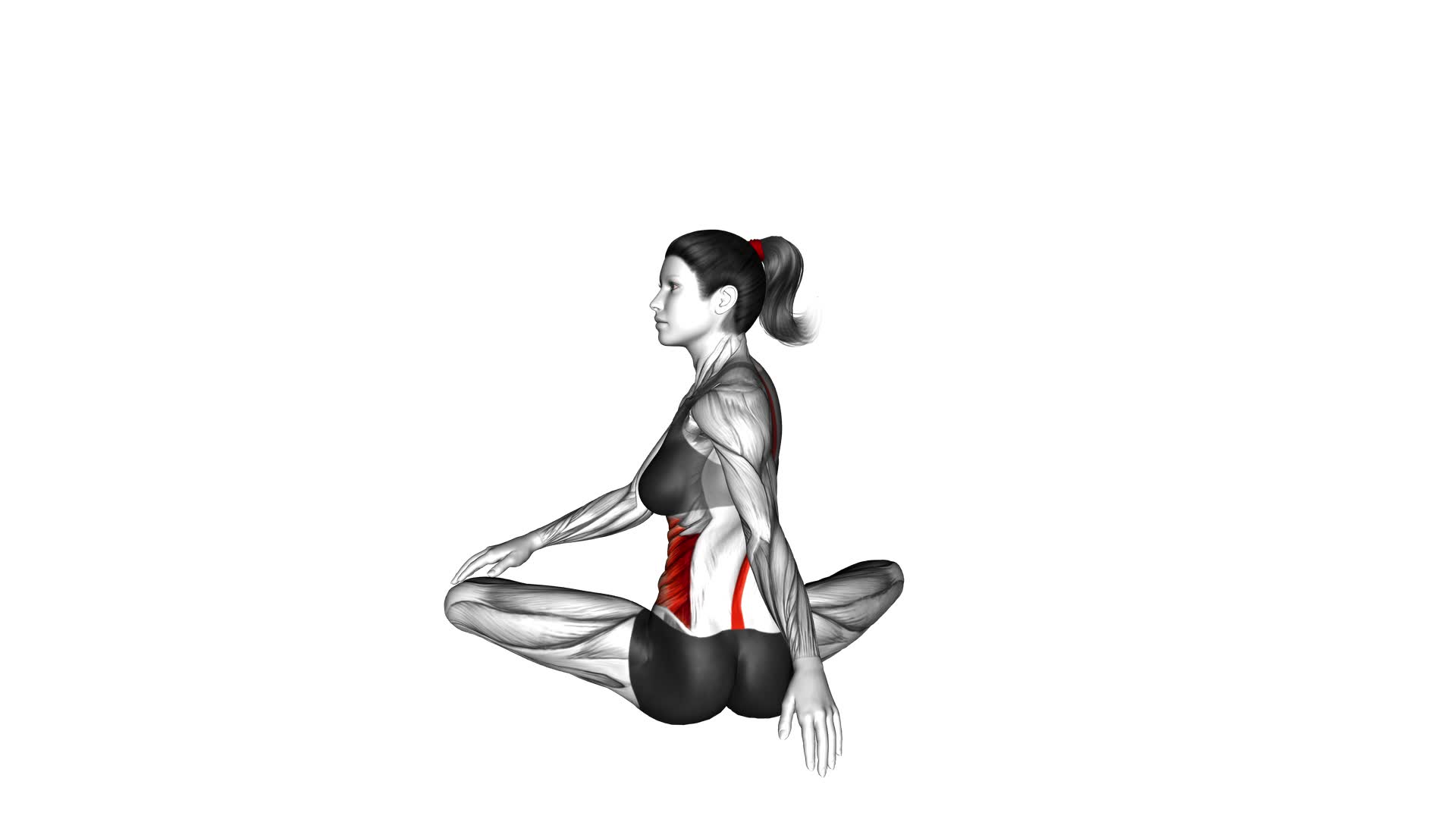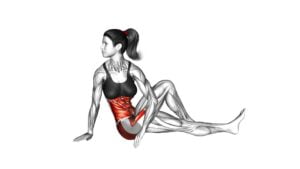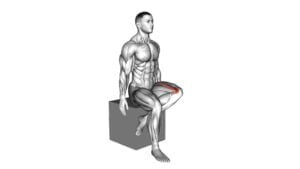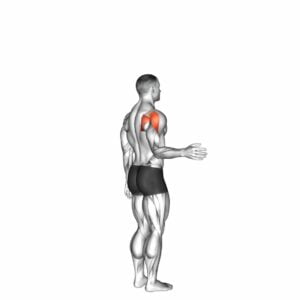Seated Rotation Stretch (female) – Video Exercise Guide & Tips

Looking to improve your flexibility and reduce tension in your upper body? Look no further than the seated rotation stretch!
Watch This Exercise Video
In this video exercise guide, we'll show you the proper technique and provide helpful tips for getting the most out of this stretch.
Whether you're a beginner or experienced in fitness, this stretch is a great addition to any routine.
So grab a mat, sit down, and get ready to feel the benefits of the seated rotation stretch!
Key Takeaways
- Improved flexibility
- Reduced muscle tension
- Increased range of motion
- Enhanced overall flexibility
Benefits of the Seated Rotation Stretch
Improve your flexibility and relieve tension with the Seated Rotation Stretch. This exercise offers several benefits, including improved flexibility and reduced muscle tension. By incorporating the Seated Rotation Stretch into your routine, you can increase your range of motion and enhance your overall flexibility. This is especially beneficial for athletes and individuals who participate in activities that require a wide range of movement, such as dancers or gymnasts.
Additionally, the Seated Rotation Stretch helps to alleviate muscle tension, which can build up due to stress, poor posture, or prolonged periods of sitting. By releasing this tension, you can experience increased relaxation and a greater sense of well-being.
To reap the full benefits of the Seated Rotation Stretch, it's important to ensure proper set-up and alignment. Position yourself on a chair or mat with your feet flat on the ground and your spine straight. Keep your shoulders relaxed and your core engaged. As you perform the stretch, focus on maintaining proper form and breathing deeply. This will help to maximize the benefits and prevent any unnecessary strain.
With the proper set-up and alignment, you can continue to improve your flexibility and reduce muscle tension effectively.
Proper Set-Up and Alignment
Get ready to position yourself correctly for the Seated Rotation Stretch by setting up and aligning your body properly. Proper set-up and alignment are crucial for maximizing the benefits of this stretch and avoiding any potential injuries.
Here are some tips to ensure you're in the right position:
- Sit on a mat or a comfortable surface with your legs extended in front of you.
- Keep your spine tall and engage your core muscles to maintain stability throughout the stretch.
- Bend your right knee and place your right foot on the outside of your left knee, keeping it flat on the ground.
- Place your left hand on your right knee and gently twist your torso to the right, using your hand as a lever to deepen the stretch.
- Hold the stretch for 15-30 seconds, focusing on your breathing and allowing your muscles to relax into the movement.
- Repeat the stretch on the other side, bending your left knee and placing your left foot on the outside of your right knee.
Incorporating the Seated Rotation Stretch into your routine can be beneficial for improving spinal mobility and flexibility. Remember to listen to your body and make any necessary modifications to ensure comfort and safety.
Step-by-Step Instructions for the Stretch
To perform the Seated Rotation Stretch, follow these step-by-step instructions to ensure proper execution and maximize the benefits of the stretch.
- Start by sitting on the floor with your legs extended in front of you.
- Bend your right knee and bring your right foot over the left leg, placing it on the floor.
- Place your left hand on your right knee, gently guiding it toward your left side.
- Reach your right arm behind you and place your hand on the floor for support.
Take a deep breath in and as you exhale, twist your torso to the left, using your left hand to deepen the stretch.
Hold this position for 15 to 30 seconds, feeling a stretch in your lower back and hips.
Slowly release the stretch and return to the starting position.
Repeat on the other side, bending the left knee and twisting to the right.
Perform 2 to 3 sets on each side, gradually increasing the duration of the stretch as your flexibility improves.
By following these step-by-step instructions, you can properly perform the Seated Rotation Stretch and experience its benefits.
This stretch helps increase flexibility in the spine, hips, and lower back, improving your overall range of motion. It also helps relieve tension and tightness in these areas, reducing the risk of injury and promoting better posture. Incorporating this stretch into your routine can enhance your athletic performance and daily activities.
Remember to listen to your body and only stretch to a comfortable point, avoiding any pain or discomfort.
Common Mistakes to Avoid
To avoid common mistakes, ensure proper execution of the Seated Rotation Stretch by following these guidelines:
- Maintain proper body alignment: One common mistake is leaning too far forward or backward during the stretch. This can put unnecessary strain on your back and neck. Keep your spine straight and your shoulders relaxed.
- Engage your core: Another mistake isn't engaging your core muscles. Your core provides stability and helps you maintain proper form during the stretch. Keep your abdominal muscles gently contracted throughout the exercise.
- Avoid excessive twisting: Many people make the mistake of twisting too far during the seated rotation stretch. Twisting beyond your comfortable range of motion can strain your back and cause injury. Gradually increase the twist as you become more flexible, but always listen to your body and stop if you feel any pain or discomfort.
By following these guidelines, you can avoid common mistakes and ensure that you're performing the Seated Rotation Stretch correctly.
Remember to maintain proper body alignment, engage your core, and avoid excessive twisting to get the most out of this stretch and prevent any potential injuries.
Variations and Modifications
To modify the Seated Rotation Stretch, you can use a resistance band to increase the intensity of the exercise. By incorporating a resistance band, you add an element of resistance that challenges your muscles even further. Start by sitting on the floor with your legs extended in front of you. Wrap the resistance band around your feet and hold the ends in your hands. As you rotate your torso to the side, pull on the resistance band to create tension. This modification not only stretches your muscles but also engages them as you work against the resistance of the band.
In addition to using a resistance band, there are other variations and modifications you can try to personalize the Seated Rotation Stretch. You can use a yoga block or a rolled-up towel to support your lower back if you find it difficult to maintain an upright posture. Another variation is to perform the stretch in a seated position on an exercise ball, which adds an element of instability and challenges your core muscles even more.
Now that you have learned about the variations and modifications of the Seated Rotation Stretch, let's move on to the next section: tips for incorporating the seated rotation stretch into your routine.
Tips for Incorporating the Seated Rotation Stretch Into Your Routine
To effectively incorporate the Seated Rotation Stretch into your routine, it's important to focus on proper form techniques. This includes maintaining a straight back, engaging your core, and gently rotating your upper body.
Regular stretching not only increases flexibility but also improves blood circulation and reduces muscle tension. Aim to perform the Seated Rotation Stretch at least 2-3 times a week for optimal results.
Proper Form Techniques
Use the correct alignment and engage your core when performing the Seated Rotation Stretch to maximize its effectiveness. Here are some key tips to ensure proper form and technique:
- Sit up tall with your spine straight and shoulders relaxed.
- Keep your feet flat on the floor, hip-width apart.
- Place your hands on your hips or behind your head.
Inhale deeply, then exhale as you rotate your upper body to the right, twisting from your waist. Hold the stretch for 15-30 seconds, feeling the stretch in your obliques and lower back. Repeat on the other side.
To modify the stretch, you can use a towel or resistance band to assist with the rotation. Aim to stretch at least 2-3 times a week to improve flexibility and prevent muscle tightness.
Remember to listen to your body and never push yourself beyond your limits.
Benefits of Regular Stretching
Regular stretching offers numerous benefits, allowing you to incorporate the Seated Rotation Stretch into your routine to improve flexibility and prevent muscle tightness.
Stretching is of utmost importance as it helps increase the range of motion in your joints, allowing you to move more freely during daily activities and exercise. By regularly incorporating flexibility techniques like the Seated Rotation Stretch, you can enhance your athletic performance and reduce the risk of injuries.
Stretching also helps to alleviate muscle soreness and improve blood circulation, which aids in muscle recovery. Additionally, regular stretching can improve your posture and help relax both your body and mind.
Make sure to incorporate the Seated Rotation Stretch into your routine to reap the many benefits of regular stretching.
Time and Frequency Recommendations
To incorporate the Seated Rotation Stretch into your routine effectively, it's important to consider the optimal time and frequency for performing this exercise. Here are some frequency recommendations and stretching techniques to help you get started:
- Start by performing the Seated Rotation Stretch two to three times per week.
- As you become more comfortable with the exercise, gradually increase the frequency to four to five times per week.
- Aim to hold each stretch for 15 to 30 seconds, focusing on deep breathing and relaxing your muscles.
Frequently Asked Questions
Can the Seated Rotation Stretch Help Improve Flexibility in Other Areas of the Body?
The seated rotation stretch can be a great way to improve flexibility in other areas of your body. Athletes can benefit from this stretch because it helps to loosen up the muscles in your back, shoulders, and hips.
Is the Seated Rotation Stretch Suitable for Individuals With Lower Back Pain?
The seated rotation stretch is a suitable option for individuals with lower back pain. It can provide relief and help improve flexibility in the area.
However, if you're looking for alternative stretches, there are other options you can try. Incorporating seated stretches into your daily routine has several benefits, including promoting better posture and reducing tension in the lower back.
Consistency is key to experiencing the full benefits of these stretches.
How Long Should Each Repetition of the Seated Rotation Stretch Be Held?
To maximize the benefits of the seated rotation stretch for flexibility, it's important to know how long each repetition should be held. Holding each repetition for around 15-30 seconds is ideal. This duration allows your muscles enough time to fully stretch and improve flexibility.
By holding the stretch, you also increase blood flow to the muscles, promoting better recovery and reducing the risk of injury.
Are There Any Precautions or Contraindications to Be Aware of Before Attempting the Seated Rotation Stretch?
Before attempting the seated rotation stretch, it's important to be aware of any precautions or contraindications. These include having lower back pain or any other existing injuries that may be aggravated by the stretch.
It's also important to consider your level of flexibility and make sure you're able to perform the stretch safely. Remember, the seated rotation stretch is designed to improve flexibility, but it's always best to consult with a healthcare professional if you have any concerns.
Can the Seated Rotation Stretch Be Performed Using a Chair With Armrests?
Yes, you can perform the seated rotation stretch using a chair with armrests. This stretch is great for improving your posture and has many benefits.
It helps to increase flexibility in your spine and shoulders, reduces tension in your neck and upper back, and promotes better alignment. By incorporating this stretch into your routine, you can relieve muscle tightness and improve your overall posture and mobility.
Conclusion
Incorporating the seated rotation stretch into your routine can provide numerous benefits, including improved flexibility, reduced muscle tension, and increased range of motion.
By following proper set-up and alignment, and using the step-by-step instructions provided, you can effectively perform this stretch.
Be mindful of common mistakes to avoid and consider variations or modifications to suit your needs.
Make the seated rotation stretch a regular part of your exercise routine to enhance your overall flexibility and mobility.

Author
Years ago, the spark of my life’s passion ignited in my mind the moment I stepped into the local gym for the first time. The inaugural bead of perspiration, the initial endeavor, the very first surge of endorphins, and a sense of pride that washed over me post-workout marked the beginning of my deep-seated interest in strength sports, fitness, and sports nutrition. This very curiosity blossomed rapidly into a profound fascination, propelling me to earn a Master’s degree in Physical Education from the Academy of Physical Education in Krakow, followed by a Sports Manager diploma from the Jagiellonian University. My journey of growth led me to gain more specialized qualifications, such as being a certified personal trainer with a focus on sports dietetics, a lifeguard, and an instructor for wellness and corrective gymnastics. Theoretical knowledge paired seamlessly with practical experience, reinforcing my belief that the transformation of individuals under my guidance was also a reflection of my personal growth. This belief holds true even today. Each day, I strive to push the boundaries and explore new realms. These realms gently elevate me to greater heights. The unique combination of passion for my field and the continuous quest for growth fuels my drive to break new ground.







